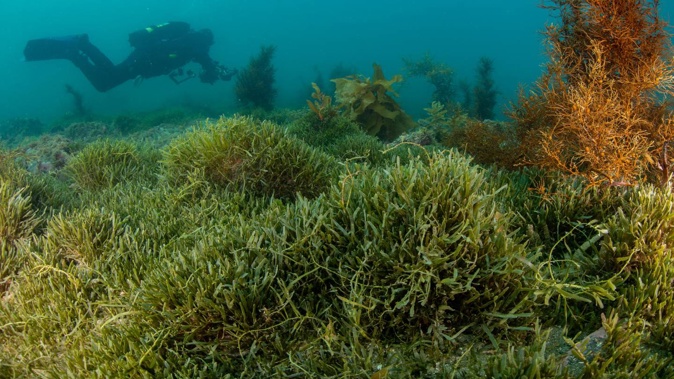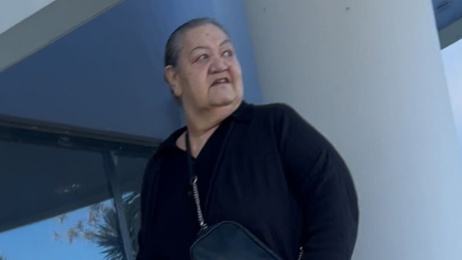
More super-spreading exotic caulerpa seaweed has been discovered off Aotea-Great Barrier Island, amid concern some boaties are flouting restrictions to control the major marine pest threat this summer.
Notorious for rapidly blanketing areas of seafloor and smothering life, the bright-green seaweed’s spread to several sites in Hauraki Gulf and the Bay of Islands has prompted fears of a looming environmental disaster for New Zealand.
The worst-hit area remains Aotea, where the foreign species was first found in 2021, and where measures including a controlled area notice and local anchoring restrictions were extended at the start of summer.
Emeritus Professor Barry Scott, a prominent molecular geneticist who’s been monitoring the Government’s response for two years, said a new patch of the highly-invasive scourge had just been discovered by a diver near Port Abercombie.
“It’s less than a metre square at the moment, which doesn’t sound like much - but we know that the infestations in Tryphena and Whangaparapara harbours grew from patches similar to this.”
Scott said caulerpa was now estimated to cover hundreds of hectares in patches from Cape Barrier in the south to the Broken Islands in the north.
“This Port Abercrombie patch suggests it’s still spreading.”
/cloudfront-ap-southeast-2.images.arcpublishing.com/nzme/G67TXOF2MJGKRPOZMCB53AKXZU.jpg)
Aotea/Great Barrier Island's marine environment has been under threat from the highly-invasive exotic caulerpa seaweed since 2021. Here, it's pictured washed up at Okupu beach in the aftermath of February's ex-tropical cyclone Gabrielle. Photo / Noel Nancekivell
Scott and others have called for a national strategy and urgent funding for local responses.
“We can’t understand why it’s taking so long,” said Kate Waterhouse, author of a briefing to incoming ministers on exotic caulerpa and chair of the Aotea Great Barrier Environmental Trust.
“All the evidence suggests acting fast and early is the only way to control it.”
To stop boats spreading caulerpa through fragments attached to anchors and fishing gear, officials put a much larger restricted zone in place on Aotea’s west coast on December 1, while funding a small team of on-water ambassadors from the island over the busy summer period to monitor boats anchoring in affected areas.
Aotea Great Barrier Local Board chair Izzy Fordham said boaties had been generally respectful of the restrictions, but she was disappointed some were ignoring or claiming to be unaware of the rules.
“We urgently need to get on top of it as soon as we find these new patches, before they get out of control,” Fordham said.
“The Abercrombie patch is likely to grow to 10 square metres within four months – we can’t wait.”
/cloudfront-ap-southeast-2.images.arcpublishing.com/nzme/O6BBAW3HSVCW3GDE2QIEMJ26AM.jpg)
This map shows where exotic caulerpa seaweed has been so far detected in the Hauraki Gulf. Source / Auckland Council
Ngāti Rehua Ngātiwai ki Aotea Trust chair Opo Ngawaka wanted officials to release funding for an Aotea based response team to get on top of the problem.
“We know what needs to be done and we have the people with the skills and knowledge on the island to do it.”
Waterhouse said dealing with the pest posed a long-term project for the new government.
“But you only need to look at the masses at Okupu, the dead scallops, the tonnes and tonnes of beach cast, to see the consequences and to know we don’t want that happening anywhere else,” she said.
“The longer they [delay] the decision to invest in local responses the worse it will get. As a coastal nation, we can’t let that happen.”
Biosecurity New Zealand’s director of readiness and response, John Walsh, said officials were aware of the new patch, along with another found at Island Bay near Cape Barrier, with both sites covered by existing legal controls.
“While we are doing all we can in partnership with iwi, councils and local communities to limit the spread of exotic caulerpa, spread to areas near where exotic Caulerpa is already found in large and dense levels is not unexpected.”
Walsh said the agency’s focus was on reducing risk of people spreading the seaweed to new areas, and its ambassadors had already interacted with more than 100 boaties at Aotea this summer.
Caulerpa is an exotic weed that upsets ecosystem balance.
“Some of those boaties were asked to move on because they had anchored in areas where anchoring is prohibited under legal controls.”
Elsewhere, he said the agency had investigated new management tools, sought independent science advice, used divers to get a better understanding of the extent of the problem, and supported mana whenua and partners to tackle the pest.
The long-term outlook, however, wasn’t optimistic.
“Advice from independent scientists, as well as our own scientists, is that eradication at a national scale is simply not feasible – nobody in the world has managed to eliminate this pest in the open ocean at the scale and depth we have it here,” he said.
“We continue to look at options for future control in the hope of finding techniques that could help remove, for example, new and small outbreaks or suppress larger populations to try to reduce further spread.”
Jamie Morton is a specialist in science and environmental reporting. He joined the Herald in 2011 and writes about everything from conservation and climate change to natural hazards and new technology.
Take your Radio, Podcasts and Music with you

/cloudfront-ap-southeast-2.images.arcpublishing.com/nzme/UUZROEYABREUHFWMDMPUR3SIJA.JPG)








